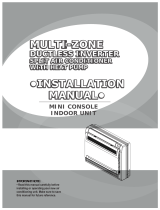
Page 4
Thank you for purchasing this air conditioner. This manual will provide you with information on how
to operate, maintain, and troubleshoot your air conditioner. Following the instructions will ensure the
proper function and extended lifespan of your unit.
Please pay attention to the following signs:
Safety Precautions 1
WARNING
• Ask an authorized dealer to install this air
conditioner. Inappropriate installation may
cause water leakage, electric shock, or re.
• The warranty will be voided if the unit is not
installed by professionals.
• If abnormal situation arises (like burning
smell), turn o the power supply and call
your dealer for instructions to avoid electric
shock, re or injury.
• DO NOT
let the indoor unit or the remote
control get wet. It may cause electric shock
or re.
• DO NOT
insert ngers, rods or other
objects into the air inlet or outlet. This may
cause injury, since the fan may be rotating
at high speeds.
• DO NOT
use a ammable spray such as
hair spray, lacquer or paint near the unit.
This may cause re or combustion.
CAUTION
General
Introduction
• DO NOT
touch the air outlet while the swing
ap is in motion. Fingers might get caught
or the unit may break down.
• DO NOT
inspect the unit by yourself. Ask an
authorized dealer to perform the inspection.
•
To prevent product deterioration, do not use
the air conditioner for preservation purposes
(storage of food, plants, animals, works of
art, etc.).
Failure to observe a warning may result in death. The appliance must be
installed by installers or contractors who are licensed HVAC professionals
and in compliance with all local, state and provincial laws.
.
Failure to observe a caution may result in injury or equipment damage.
WARNING
CAUTION
• DO NOT
place items that might be aected
by moisture damage under the indoor unit.
Condensation can occur at a relative
humidity of 80%.
• DO NOT
expose heat-producing appliances
to cold air or place them under the indoor
unit. This may cause incomplete combustion
or deformation of the unit due to the heat.
• After long periods of usage, check the
indoor unit to see if anything is damaged. If
the indoor unit is damaged, it may fall and
cause injury.
• If the air conditioner is used together with
other heating devices, thoroughly ventilate
the room to avoid oxygen deciency.
• DO NOT
climb onto or place objects on top
of the outdoor unit.
• DO NOT
operate the air conditioner when
using fumigant insecticides. The chemicals
may become layered with the unit and
endanger those who are hypersensitive to
chemicals.
• DO NOT
let children play with the air
•
The air conditioner can be used by children aged
8 years and older and people with reduced
physical, sensory or mental capabilities, or lack
of experience and knowledge, if they have been
given instruction on how to properly and safely
operate the system.
• DO NOT
operate the air conditioner in a wet
room (e.g. bathroom or laundry room). This
can cause electrical shock and cause the
product to deteriorate.
Safety
Precautions
conditioner.
• DO NOT
operate the air conditioner with
wet hands. It may cause electric shock.
• DO NOT
touch the evaporator coils inside
the indoor unit. The evaporator coils are
sharp and may cause injury.
















